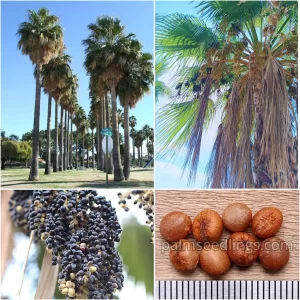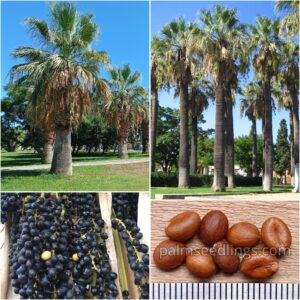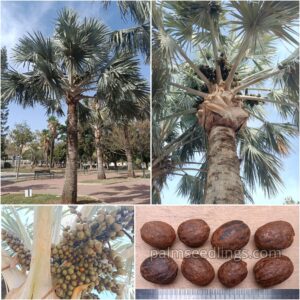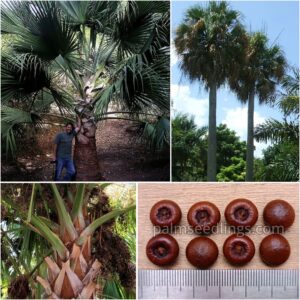Menu
5,00 € – 30,00 €
Product Details
Trithrinax brasiliensis, commonly known as the Blue Needle Palm, is a robust, slow-growing palm native to South America, particularly Brazil, Argentina, and Uruguay. Known for its hardy nature and spiky leaves, it is a highly drought-tolerant and cold-hardy species with a striking blue-green appearance.
-Germination Rate: Very high
-Germination Time: Medium/Slow
-Germination Difficulty: Medium
-Growth speed: Medium
Select Quantity
*Shipping cost is calculated automatically in the cart after adding the products.
Trithrinax brasiliensis (Blue Needle Palm)
Habitat: This palm is native to the dry savannas, scrublands, and rocky regions of southern Brazil, northern Argentina, and Uruguay. It thrives in environments with poor, well-drained soils and can tolerate long periods of drought. It is commonly found in open, sunny areas where it can endure high heat and occasional frosts.
Outstanding Features: The Blue Needle Palm is named for its spiny, needle-like leaf bases that protrude from the trunk. Its most distinctive feature is its stiff, fan-shaped leaves that are bluish-green, giving the palm a unique, ornamental appearance. The trunk is covered with fibrous material, and older specimens may develop a distinctive, rough-textured, multi-trunked appearance.
General Appearance: Trithrinax brasiliensis grows to about 10 to 20 feet in height, with a thick, rough trunk that may branch over time. The leaves are palmate (fan-shaped), stiff, and spiky, with a bluish-green color that gives the tree an attractive, silver-blue hue. The trunk is typically covered with fibrous, rough material, and the spiny, sharp leaf bases give it a somewhat armored appearance. The palm produces small, round, yellowish-brown fruits.
Applications: This palm is ideal for dry, arid landscapes and is often used in xeriscaping, rock gardens, or as a striking focal point in tropical or desert-style gardens. Its rugged appearance and cold tolerance make it a unique ornamental tree in regions where many tropical palms cannot survive. Trithrinax brasiliensis can also be used as a natural barrier due to its spiny, protective foliage.
Adaptability: The Blue Needle Palm is exceptionally adaptable to a range of harsh environmental conditions. It is highly drought-tolerant and thrives in poor, rocky soils with little water. It prefers full sun but can tolerate partial shade. It requires minimal maintenance once established and is resistant to pests and diseases, making it a resilient option for challenging landscapes.
| Weight | N/A |
|---|---|
| Quantity | 10 Seeds, 100 Seeds, 500 Seeds, 1.000 Seeds, 4.000 Seeds |




All rights reserved PalmseedlingsⓇ 2025.